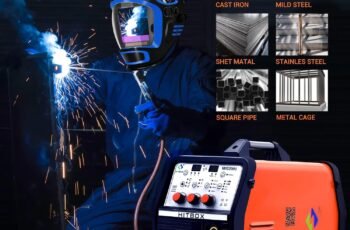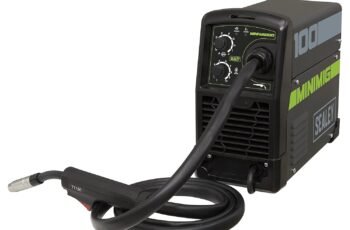Ad Blocker Detected
Our website is made possible by displaying online advertisements to our visitors. Please consider supporting us by disabling your ad blocker.
When using a MIG welding machine, your safety should be the top priority. You’ll need to gear up with the right protective equipment, like a welding helmet and flame-resistant clothing, and establish a safe workspace free from hazards. But there’s more to consider, like managing weld fumes and keeping your equipment in check. How do these steps fit together to ensure a safe welding environment?
Essential Protective Gear and Personal Protective Equipment
When it comes to MIG welding, ensuring your safety with the right protective gear is crucial.
Start with a welding helmet; auto-darkening models adjust to arc intensity, while passive lenses provide fixed shade. Select protective filters with shade numbers 2–14 based on intensity, complying with OSHA guidelines. Complement helmets with goggles or hand shields, and avoid contact lenses due to UV/IR risks. Wear flame-resistant head coverings under helmets to prevent neck burns. Welding helmets and hand shields provide critical protection for the eyes and face from intense light, radiation, and flying debris.
For skin protection, choose flame-resistant clothing like leather or FR cotton. High-collar jackets and aprons or sleeves protect the neck, torso, and arms. Insulated gloves with gauntlet cuffs shield hands and wrists, while respirators and fume extraction systems handle hazardous fumes.
Finally, ensure tight-fitting gear and durable footwear for full-body safety.
Fire Safety Precautions and Hazard Management
Although MIG welding is a highly efficient process, it’s crucial to prioritize fire safety to prevent potential hazards. Start by clearing flammable materials within a 35-foot radius. Drain any containers of flammable liquids and grind away hazardous coatings like paint to avoid toxic fumes. Use fume extractors to manage airborne hazards and ensure ventilation to disperse gases. Position your workspace away from flammable items and block unprotected areas with welding screens. Regular checks for flammable materials near welding zones help maintain safety. Monitor sparks carefully and keep the area free of debris. Implement a fire watch policy with inspections immediately and 30 minutes after welding. Keep extinguishers accessible, secure gas cylinders, and organize cables to prevent mishaps. Restrict access to trained personnel and store supplies safely. Document all safety protocols diligently.
Preparing Your Workspace for Safe Welding
A well-organized workspace is essential for safe and efficient MIG welding. Keep your area clear of debris and tools to prevent tripping and fire hazards. Remove any combustible materials within 35 feet of your welding zone.
Secure gas cylinders upright to prevent accidental tipping or release. Organize welding cables to avoid tripping hazards and electrical interference. Conduct pre-welding safety checks on equipment and the work area to ensure that everything is functioning properly and to identify potential hazards.
Ensure proper ventilation to minimize exposure to harmful fumes; use respirators if necessary. Ground your welding machine correctly and avoid wet conditions to prevent electrical shocks.
Inspect cables for damage before use, and wear rubber-soled shoes. Store gas cylinders and flammable materials safely, away from sparks.
Provide adequate lighting to enhance visibility and accuracy during welding tasks.
Regular Equipment Maintenance and Inspections
Consistent and thorough equipment maintenance is vital for ensuring the safety and effectiveness of MIG welding operations. Start by checking power supply connections for security and inspecting the machine for any physical damage. Calibrate welding settings regularly and remove debris from wire feeders to prevent jams. Ensure proper ventilation in the welding area to reduce the risk of hazardous fumes. Follow manufacturer guidelines for maintenance schedules and component replacements.
For the gas system, secure cylinders upright, test hoses for leaks, and verify gas flow rates. Inspect regulators and valves for damage, and store cylinders in a cool, dry place.
Maintain the torch by replacing contact tips and inspecting nozzles. Check wiring and cables for wear, ensuring electrical connectors are tight.
Develop a maintenance schedule, record inspections, and conduct annual full-system checks for optimal performance.
Ensuring Proper Ventilation and Health Safety
Proper ventilation and health safety are crucial in MIG welding operations to protect workers from harmful fumes and gases. You need to follow minimum ventilation requirements: OSHA mandates 2,000 CFM per welder or six air changes per hour. Engineering controls should be prioritized over PPE for effective weld fume protection. Natural ventilation is only allowed if the workspace exceeds 10,000 cubic feet per welder with ceilings of 16 feet. Ensure unobstructed airflow and proper room dimensions. For fume extraction, MIG welding guns should have at least 100 CFM, increasing by 30% for high-parameter tasks. Local exhaust hoods need to provide 100 ft/min air velocity. Always check pressure drops in ducting to maintain effective CFM. Incorporate PPE like respirators if ventilation falls short. Regularly monitor exposure and validate CFM at stations.
Implementing Physical Safety Practices
While ensuring ventilation and health safety are vital, it’s equally important to focus on physical safety practices to maintain a secure welding environment.
Start with proper posture: keep your body ergonomically aligned to avoid muscle strain, and position workpieces at a comfortable height to prevent neck and back issues. Steady your hands to minimize abrupt movements that could cause sparks.
Wear the right protective gear—helmets, gloves, and flame-resistant clothing shield you from burns and electrical shocks. Always inspect cables for damage and avoid touching live components.
Secure your workpieces to maintain stability, and use dry, insulated mats to prevent electrical grounding. Keep your workspace organized and well-lit to reduce the risk of tripping or injury.
Conclusion
When using a MIG welding machine, always prioritize your safety by wearing the right protective gear, like a welding helmet and flame-resistant clothing. Keep your workspace tidy and free from flammable items, and ensure proper ventilation to handle fumes. Regularly check your equipment for leaks and secure gas cylinders. Don’t forget to implement a fire watch policy and have fire extinguishers nearby. By taking these precautions, you can weld safely and confidently.



